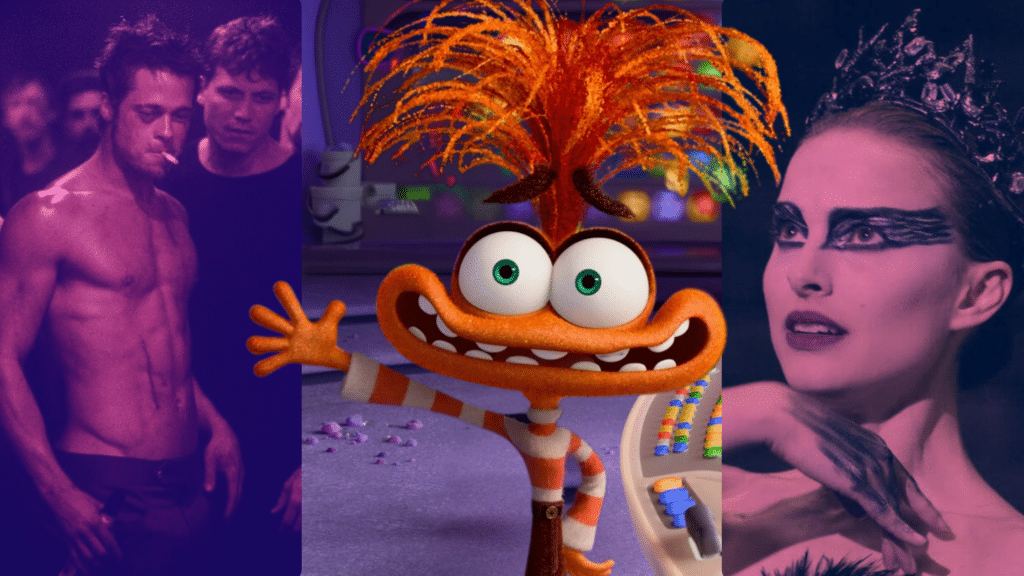
Introduction
Whether we like it or not, conflict drives every story ever told. Opposite forces colliding in the story world, each with their own motive and end goal. Such forces can be either external or internal, wedged deep in a character’s psyche, or a physical manifestation that we cannot see.
Conflict can come in two forms: external and internal. External conflict is a struggle between a character and an outside force, for example nature, society, situation, or another person. Conversely, internal conflict rages within a character themselves, two sides of them battling for dominance.
It’s common to pit internal and external conflict against each other. Which one comes out on top as causing the most chaos within a story? Which one creates a more compelling read or watch? In today’s article, we’ll be throwing out the old and bringing in the new: what if we combined internal and external conflict and explored how they work together to create a captivating story?
By intersecting external and internal conflict, we immediately open the possibilities for more dynamic storytelling. It always comes down to the mechanics of the real world. No one faces battles with only outside forces; we all have internal conflict going on inside us, and vice versa. Stories are a mirror reflecting what we experience in real life, so let’s make sure they do.
Conflict is key. So is using the right software to craft your story. Get started with Celtx today!
Spotlight on External Conflicts
Before we explore the potential of intersecting both external and internal conflicts, each deserves their own time in the spotlight. First, we’ll look at the various examples of external conflict and how they’re showcased in some of our favorite movies.
Case Studies:
Wonka (2023)
One of 2023’s best loved family films reincarnated the character of Willy Wonka, and his rise to creating the most magical chocolate factory we know and love.
External conflict plays a huge role in challenging Wonka in the pursuit of his dreams to become a chocolatier. From battling against the three greedy chocolate tycoons Slugworth, Prodnose and Fickelgruber, to escaping the clutches of Mrs. Scrubbit and the debt she holds over him and his new friends, Wonka has no shortage of hoops to jump through to achieve his goal.
But he has more than one debt to pay when he finally comes face to face with Lofty, the disgruntled Oompa Loompa who’s been stealing Wonka’s chocolate creations as recompense for the cocoa beans Wonka stole from Loompaland right under his nose.
With so many obstacles to overcome, the story of Willy Wonka’s journey to prominence is an engaging and exciting one.

Related: What Exactly is a Movie Script? (A Full Breakdown)
Parasite (2019)
Parasite investigates the wider issues of social class and the interactions between the upper and lower classes of society through the prospective of the Kim and Park families.
While this is thought to be the initial focus of the movie, it soon reveals its true meaning and shines a light on the interactions between families of the same class. In this instance, the Kim and Mun-Kwang families battle to be seen by those of higher social standing. Despite working towards similar goals, these families use fake identities and attempt several methods to outsmart and eliminate each other from the Park home.
There is a lack of class solidarity in the movie, which adds an interesting angle of commentary towards social classes and how the conflict is usually depicted between upper and lower classes. Writer and director Bong Joon-ho used many visual motifs to highlight household hierarchy, including staircases and different levels of apartments.
Parasite commented on hierarchy and the conflict within classes, and also families.
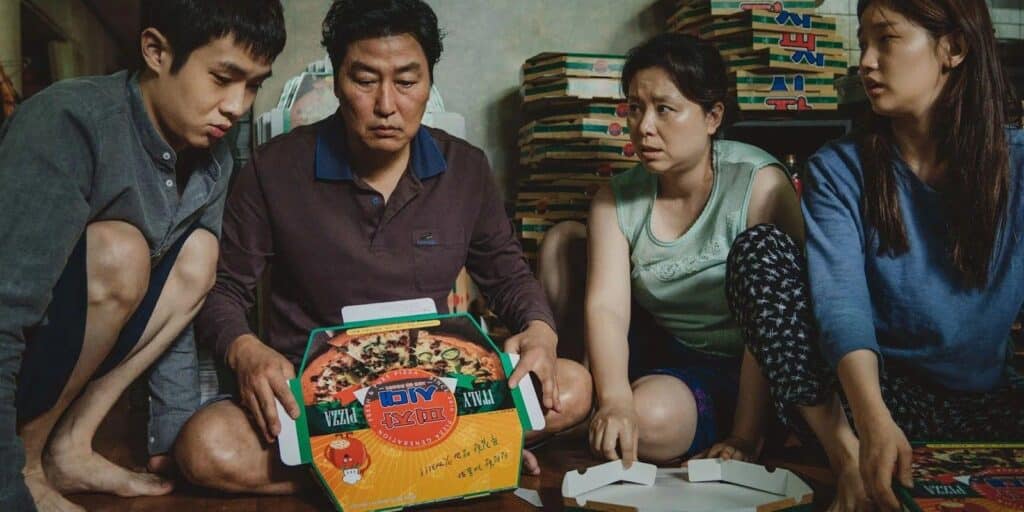
Get Out (2017)
Jordan Peele’s 2017 thriller is renowned for its social commentary and critique of ‘colorblindness’ as a concept.
The external conflict is in the racial prejudices of the Armitage family, and how protagonist, Chris, is a mere aesthetic for them to use in their transplants. This is shown through the silent auction, in which Chris himself is auctioned off to a blind man, to restore his eyesight.
The battle of control is another aspect of the conflict within the movie, with Missy Armitage’s use of hypnotism and Chris’ eventual battle against that when he hits rock bottom. In turn, this links to the social and racial commentary, where the Armitage family sees Chris as a mere commodity, to whom they can do whatever they like.
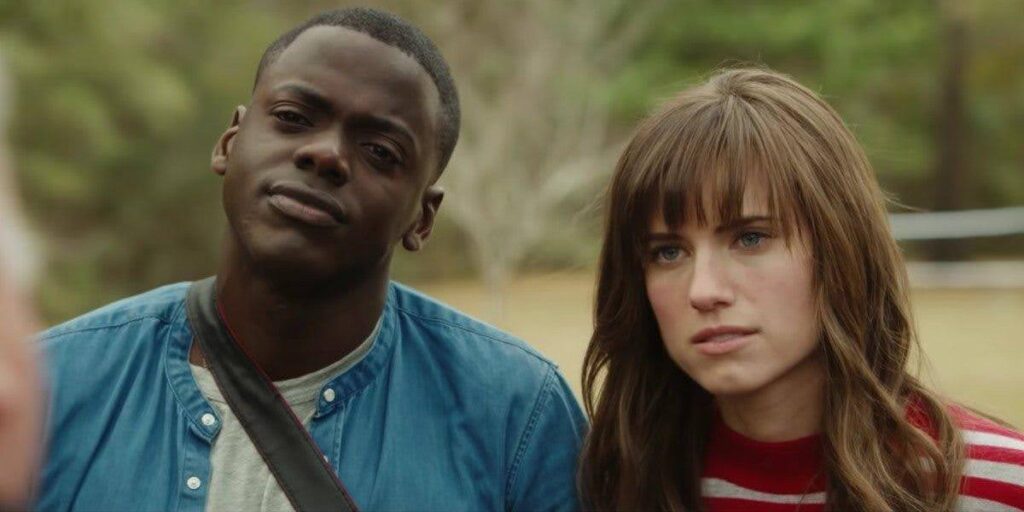
Ready to start a fight? Start crafting compelling conflicts with Celtx today!
Cast Away (2000)
Nature is the driving force of external conflict in Cast Away and the unforgiving conditions of the tropical island on which Fed-Ex delivery driver Chuck Norland becomes stranded following a plane crash. Throughout his stay on the island, Chuck is challenged by the lack of food and water, the ferocious tide that prevents him from escaping on his makeshift raft.
The external forces around Chuck force him to stay on the island for four years and eventually adapt to his new life, surrounded by the items from the parcels that’ll never be delivered. That is until a piece of the outside of a portable toilet washes up, allowing him to float out to sea and be rescued.
The Chuck we know at the end of the movie, wouldn’t have become who he is if he hadn’t endured what he did on the island. External conflict has a way of changing us, and our characters, internally.
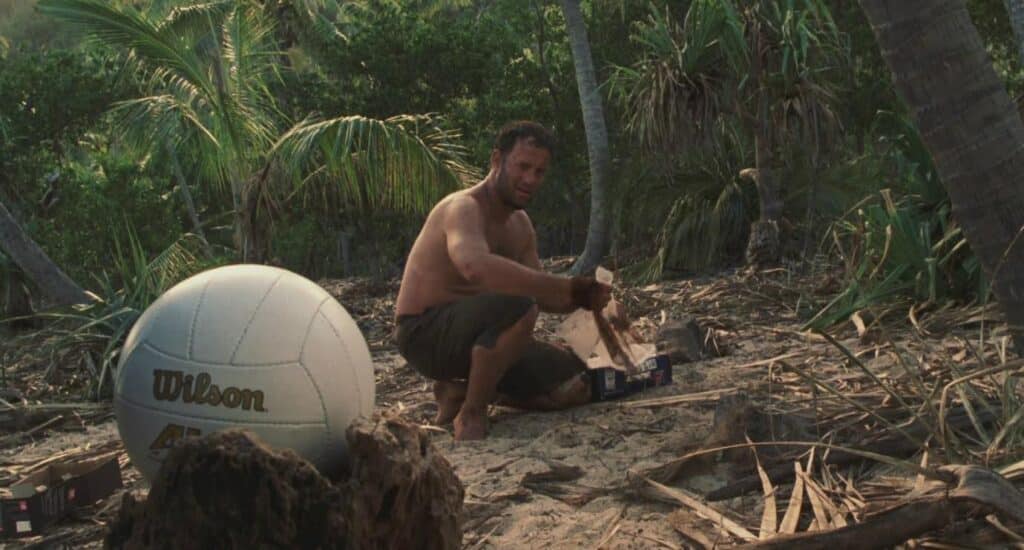
Exploring Internal Conflicts
On that note, let’s move onto internal conflict and how they’ve impacted some of the most popular characters on the big screen.
Case Studies:
Oppenheimer (2023)
While the story of Oppenheimer centers around the development of the atomic bomb, the movie actually captured the titular character’s personal conflict surrounding the implications of such a weapon.
J. Robert Oppenheimer suffered an internal battle where he was forced to play God, placed on a pedestal in most key stages of his life: as a student, a young professor, and finally as a ground-breaking and influential scientist.
Alongside the god-like elements of Oppenheimer’s character and mission, we see the personal effect this has on him as he faces humanity’s mortality in the face of the atomic bomb. While his work could end the war quickly, the consequences will be inevitably devastating. This is a dilemma Oppenheimer must work through.
In the background, we also get insight into Oppenheimer’s personal struggles, as we see just how human he is in his flaws and the way he treats those closest to him. He betrays his wife and comes across as self-centered. Despite these flaws, we as an audience still relate to him as he comes to terms with what he feels he must do.
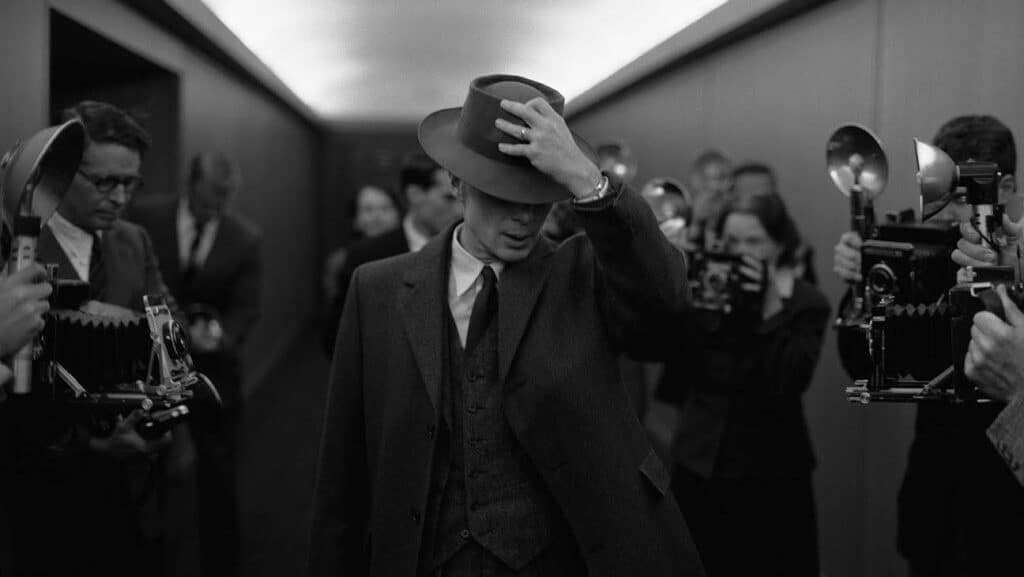
Black Swan (2010)
Natalie Portman’s character Nina Sayers is the central character of Black Swan. The entire movie focuses on her internal struggles as a principal dancer in a new production of Swan Lake. The role she takes on is a dual one – both White and Black Swan, but soon the perfectionism demanded within the role, and her struggle to embody the black swan as well as the white, drive her into a downward spiral.
As Nina finds herself embroiled in her internal battle, as she overthinks, strives for perfectionism, and becomes convinced that her alternate, Lily, is after her. By the end of the movie, Nina is the one who destroys herself.
Black Swan is a masterful representation of how we as humans can destroy ourselves from within and how powerful the ego can be, for better or worse.

Fight Club (1999)
Struggling with our identities is one of the trials many of us experience as humans. In Fight Club, the very fact that the protagonist is an unnamed Narrator shows how out of touch some of us are with ourselves and the world around us.
Frustrated with his job and lifestyle, he joins emotional support groups, but doesn’t use them for their intended purpose. Yet his presence is fraudulent: he is only there to cure his insomnia through expressions of emotional vulnerability. When he’s forced to stop, his insomnia returns, causing him to hallucinate and his alter-ego Tyler Durden to come to the surface.
Tyler gradually takes over the Narrator’s psyche, slowly destroying himself and the society he’s disillusioned with. But when the Narrator realizes what’s happening, it’s almost too late.
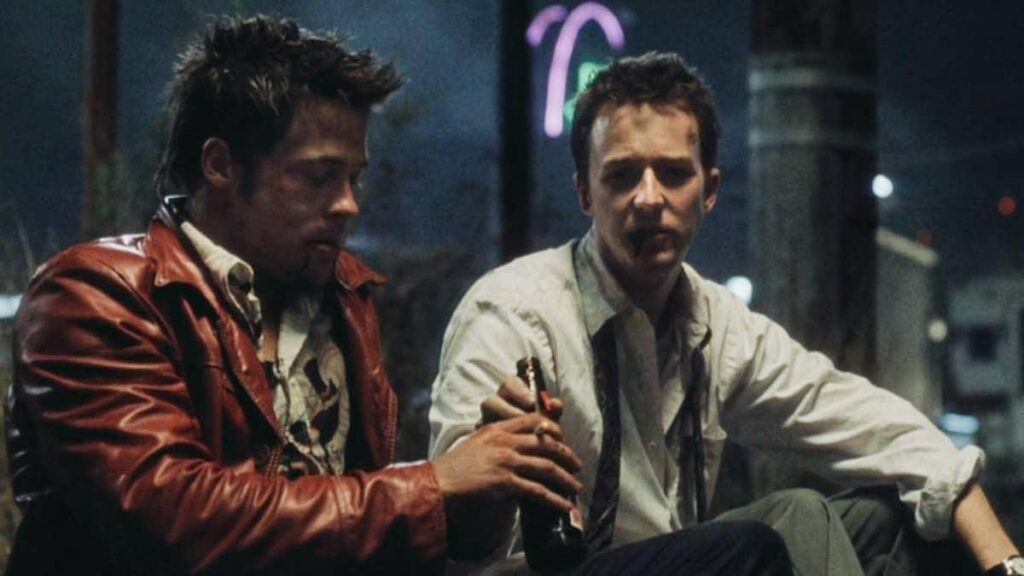
New to screenwriting? Here’s a great place to start: Three Act Structure in Screenwriting 2023 [A Complete Guide]
Intersecting Internal and External Conflict
Both internal and external conflicts are vital in crafting a great story. As we’ve seen with our case studies so far, one may be more prominent than the other, however, they ultimately fuel each other.
So, let’s take a look at some movies that are a true masterclass in combining internal and external conflict.
Inside Out 2 (2024)
Both Inside Out movies have been a phenomenal box office success, with audiences of all ages charmed by Riley’s story.
All of us have been through those awkward teenage years where we’re trying to work out who we are. That’s exactly what Riley is going through in terms of internal conflict, trying desperately to hold onto her sense of self as she experiences new emotions, notably Anxiety, who is manifested as a physical character.
The external conflict which reinforces Riley’s warped sense of self is the fact that she’s going through puberty (nature) and is just about to start high school, which brings its own social challenges in making new friends and navigating a new location.
Feeding back into the internal conflict, these natural, social and physical challenges Riley faces, then causes Anxiety to make Riley believe she’s not competent enough to navigate her own life. The cycle continues, with Riley eventually overcoming the adversity, making new friends, succeeding in hockey try-outs and, most importantly, staying true to herself.
How ‘Inside Out 2’ Is Helping Adults Better Understand Their Anxiety || Self.com

The Dark Knight (2008)
It would be ideal if Batman’s only task in The Dark Knight was just to prevent the Joker from wreaking havoc on Gotham City. However, that isn’t the case, as he’s hindered in his efforts by his own internal struggles.
Doubt constantly riddles Batman, as he begins to believe his impact on Gotham. Does he have the right to determine right from wrong and impose that upon others?
This doubt could also stem from his sense of betrayal after he learns the truth about his father, Thomas Wayne. If what he knew to be true was actually a lie, then can he trust anyone, including himself? This has a profound effect on how Batman approaches his fight with the Joker.
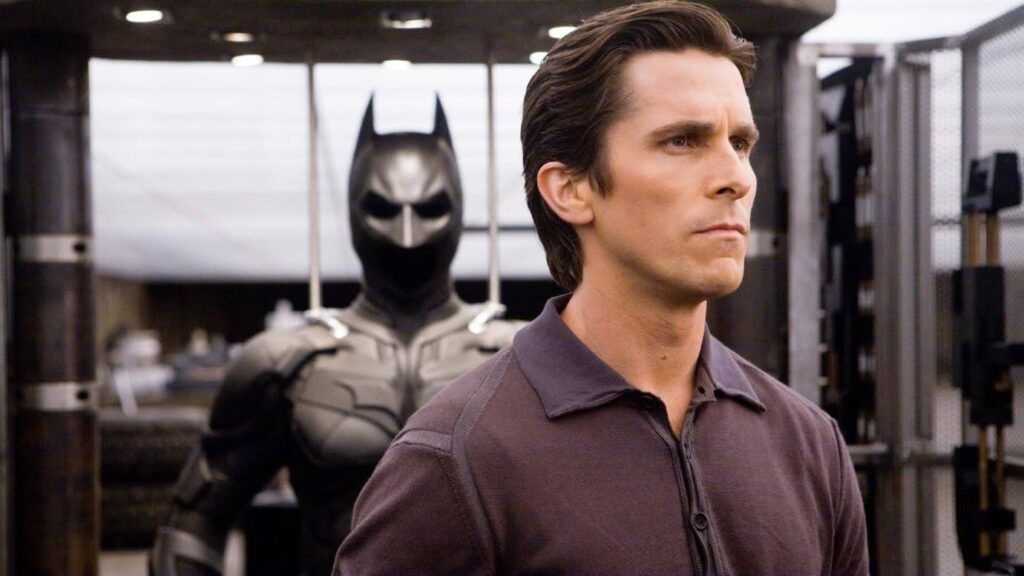
References we love: Anatomy of a Story by John Truby
Creating Dynamic Narratives
But how can you create poignant and intricate stories combining both internal and external conflict? Here are a few top tips to help you feed them into each other in your own scripts:
Use the cause-and-effect approach
Consider how one conflict can cause another. What can happen externally that directly affects a character’s internal workings? For example, if a character needs to obtain money to pay off a debt, they could have an internal battle deciding how to get it – either by legal means or doing something potentially unpleasant.
Keep your characters on their toes
Conflict is a stick with which to beat your characters. It sounds harsh, but it’s true. Continuously throw challenges at them or evolve existing ones to really put them to the test and incite a reaction.
Use internal conflict as resolution
Once you’ve sent your characters to rock bottom, you need to give them the opportunity to resolve their inner conflict and character arc. This doesn’t mean your external conflicts need to also be resolved. Leaving some elements lingering in the background can ensure your audience remains engaged and excited.
Conclusion
Combining internal and external conflicts creates richer, more dynamic narratives that resonate with audiences. While external conflicts provide the physical and situational hurdles for characters to overcome, internal conflicts delve into their psychological and emotional struggles, adding layers of complexity.
When both types of conflict intersect, they reinforce each other, allowing for more authentic and engaging storytelling. The real world reflects this duality, with our external challenges often triggering internal battles and vice versa.
Why not try blending these elements yourself to craft stories that entertain and reflect the depth of the human experience? Let us know how yours turns out on our social media pages! See ya there!
Want to dive deeper into characters? We’ve got you covered. Try these articles next!
- Character Foil: The Secret Ingredient for Dynamic Duos in Screenwriting
- Developing Your Characters
- What is a Flat Character?
